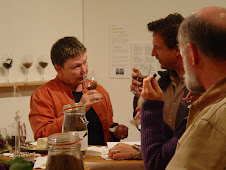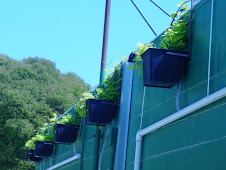
Alexis Rockman
Carol Selter
Christy Rupp
Free Soil
Free Fruit/Fruta Gratis
JohnKo Systems Unlimited/
Old World Innovations
Laura Parker
Matthew Moore
Rachel Major
Shada/Jahn
Susan Leibovitz Steinman
Ted Purves and Susanne Cockrell
Wowhaus
Hybrid Fields was a group exhibition presented Fall 2006 at the Sonoma County Museum, which included thirteen contemporary artists and collaboratives, and eight site-specific installations/projects. These artists create socially engaged art that inhabits a hybrid space where art and life, art and agriculture, converge; exploring philosophies for growing food, distributing food, and consuming food.
Sonoma County is a unique agricultural community supporting small farmers who have raised livestock and a multitude of crops through the years, including apples, hops, prunes, and, increasingly, grapes. As new technologies have expanded the capacity for producing more food, faster, through mechanization, hybridization, and genetic engineering, questions have been raised as to the environmental and social impact of such practices.
These artists incorporate humor, metaphor, research, fictive narratives, and interventions to create an expanded context for contemplating how far food travels from the field to the supermarket, the waste of unharvested crops, the conversion of farmland for housing, and the lack of biodiversity that commercial farming brings. Their art presents a context for considering the political and cultural implications of agricultural transformations and, in some cases, provides research-based information that is not likely to be considered in our daily transactions as consumers.
Patricia Watts, former Chief Curator at the Sonoma County Museum and founder/west coast curator of ecoartspace
The Artists and Works
Ted Purves and Susanne Cockrell based in Oakland, California, presented Sonoma Preserve, a community-based project inviting Sonoma County residents to submit homemade canned goods for exhibit, to be judged for a potential cash prize and to be accessioned into the Museum's permanent collection. Amy Franceschini of Free Soil in San Francisco presented the fourth iteration of F.R.U.I.T., an installation including a re-created fruit stand with plastic oranges and a stack of fruit wrappers containing information about Sonoma County agriculture for visitors to take away. Laura Parker presented a soil bar entitled Taste of Place, where you could smell the soil from a local farm and then taste the food that was grown in that soil, to experience the terroir. John Colle Rogers of JohnKo Systems Unlimited, in collaboration with Mariel Triggs of Old World Innovations, presented The Sonoma County Mammalian Enology Experimental Pasturelands (MEEP), a humorous presentation of a fictive corporate proposal that combined the region's need to protect biodiversity in farming and to sustain economic growth. Rachel Major re-created a meat market with shelves of fluffy toy-like cuts of "raw meat," a playful conceptual representation of our disassociation from meat production. Christy Rupp, a New York artist presented food containers with corporate logos that question and comment on the genetically engineered food revolution. Alexis Rockman, a New York painter who envisioned The Farm, a large-scale painting in which all the foods are technologically designed to maximize profits. Photographer Carol Selter presented an interconnected grid of tiles, entitled Fruition, which documented the food cycles of her local community garden.
And, outside the Museum walls, Susan Leibovitz Steinman installed a temporary garden near the entrance, entitled Sweet Survival, a pentagon-shaped urban apple orchard designed to propagate wild apples for future gardens. Free Fruit/Fruta Gratis was an action performed by Sonoma County artists Pam Bolton and Cindy Cleary, in which underutilized fruits from the region were placed in parks and neighborhoods in downtown Santa Rosa; a chalk arrow on the sidewalks invited pedestrians to take away these gifts for free. Arizona farmer and artist Matthew Moore presented a rooftop intervention entitled Green Roof on a small green building adjacent to the Museum; there he grew a crop of hops as an aesthetic response addressing land use and development, asking the question "where will we grow food in the future?" Wowhaus artists from Sonoma County, Scott Constable and Ene Osteraas-Constable, presented Tree Trust True, a social-interaction food-tasting event that convened on an outdoor banquet table made from a fallen tree that seated up to forty people. And, in the Contemporary Project Space, artists Marisa Jahn and Steve Shada of Shada/Jahn presented Swan Song, a lyrical contemporary art installation with a live fruit tree and constructed xylophone rendering the sound of falling fruit as a metaphor for the disquieting loss of un-harvested foods.
PUBLIC PROGRAMS included:
SOIL BAR Taste of Place (monthly)
BEER TASTING History of Hops
FREE FAMILY DAY Harvest at the Sunflower Garden
FILM SCREENING The Real Dirt on Farmer John
PANEL DISCUSSION Interventionists with Aaron Gagh, Shannon Spanhake, Cindy Cleary and Pamela Bolton.
SEED EXCHANGE with Occidental Art and Ecology Center
FREE FAMILY DAY Wowhaus Tree Table Tasting
SONOMA PRESERVE Award Ceremony/Tasting
PANEL DISCUSSION/SCREENINGS with Deborah Koons Garcia (The Future of Food) and Jed Riffe/Emiko Omori (Ripe for Change).
BYOD Bring Your Own Dirt/Taste of Place
PANEL DISCUSSION The Farmer Feed Us All with local farmers
BEER TASTING History of Hops
FREE FAMILY DAY Harvest at the Sunflower Garden
FILM SCREENING The Real Dirt on Farmer John
PANEL DISCUSSION Interventionists with Aaron Gagh, Shannon Spanhake, Cindy Cleary and Pamela Bolton.
SEED EXCHANGE with Occidental Art and Ecology Center
FREE FAMILY DAY Wowhaus Tree Table Tasting
SONOMA PRESERVE Award Ceremony/Tasting
PANEL DISCUSSION/SCREENINGS with Deborah Koons Garcia (The Future of Food) and Jed Riffe/Emiko Omori (Ripe for Change).
BYOD Bring Your Own Dirt/Taste of Place
PANEL DISCUSSION The Farmer Feed Us All with local farmers
REVIEWS
- “Hybrid Fields,” Johanna Kolodny. borborygmus: Rumblins from the World of Food. Gastronomica: The Journal of Food and Culture. Spring 2007. pp. 4–5.
- “Hybrid Fields at the Sonoma County Museum.” Barbara Morris. Artweek. February 2007. pp. 12–13.
- “Artworks in 'Hybrid Fields' Offer Food For Thought,” Miriam Owen. San Francisco Chronicle, October 21, 2006. Section F, page 6.
- “Dystopia Now: Hybrid Fields Anything But Bucolic,” Gretchen Giles. North Bay Bohemian. September 13-19, 2006.
- "Art Farms," Justin Clark. Plenty magazine, Oct/Nov 2006. pp. 70-79.
Hybrid Fields exhibition brochure & K-12 Educator Guide available upon request at tricia@ecoartspace.org






.jpg)

